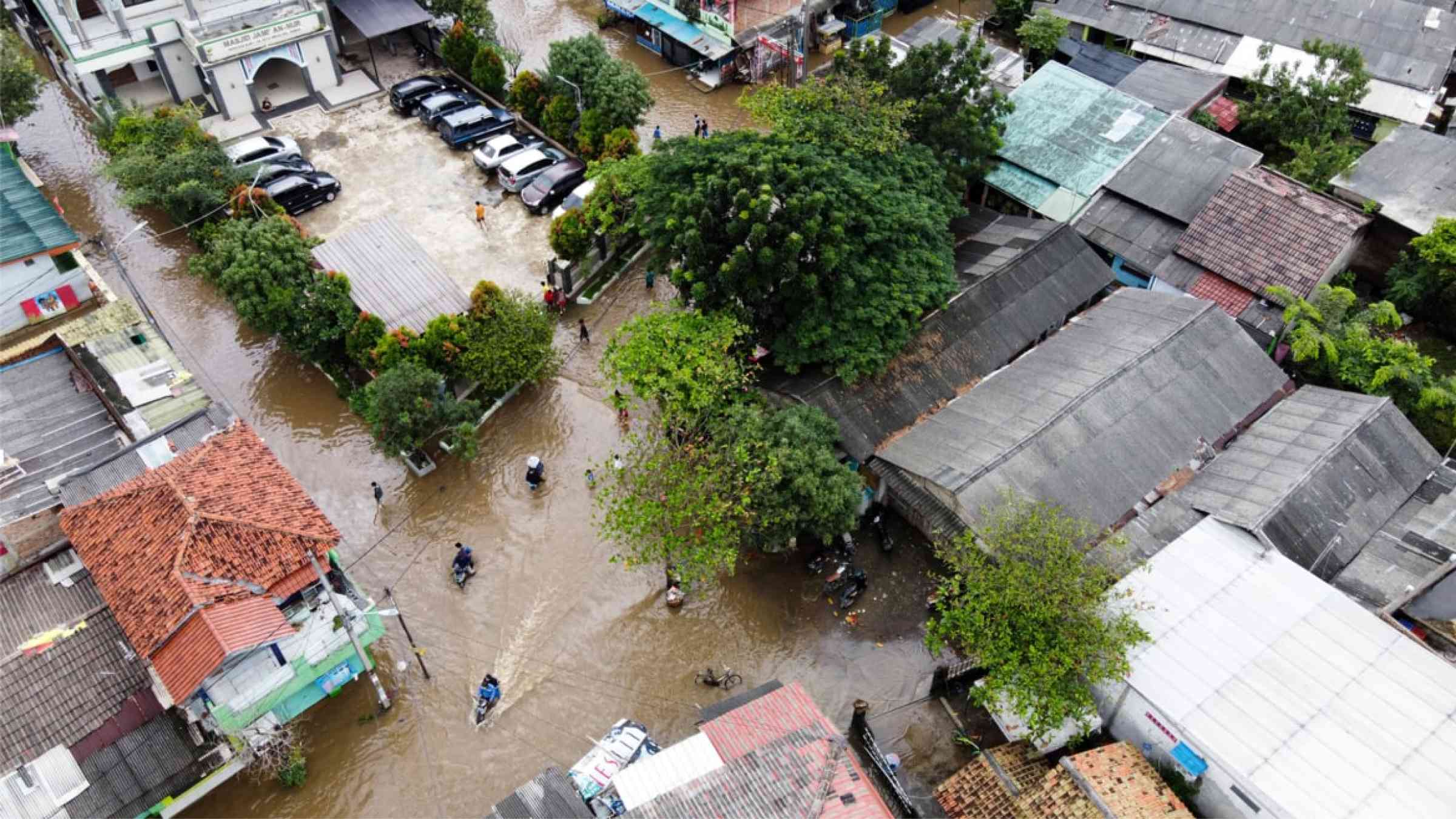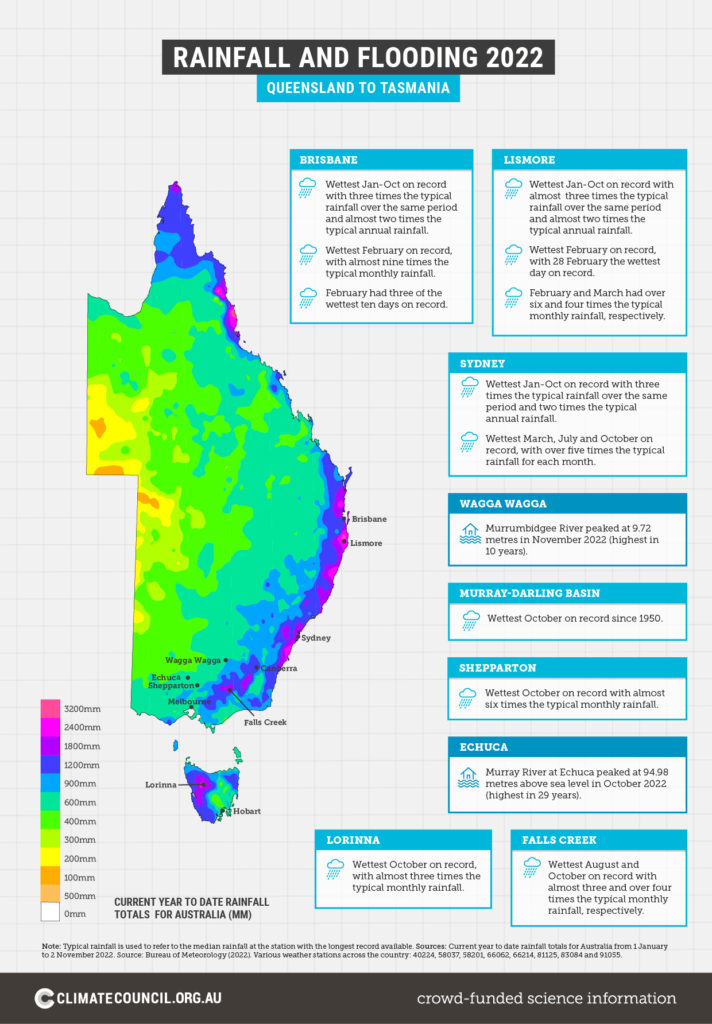The great deluge: Australia’s new era of unnatural disasters

2022 will be remembered as the year of the Great Deluge, when record-breaking rain and floods lashed large parts of Eastern Australia, causing untold devastation for Australians and our economy.
Climate change, driven by the burning of coal, oil and gas, was a major factor in the Great Deluge. It is consigning Australia to an era of climate disasters that we are not prepared for. This report is a stark warning that this is not over yet, and a call for all levels of government to speed up their emission reductions and disaster preparation efforts.
This year has seen large parts of Eastern Australia experience record-breaking rainfall and floods. From Queensland down to Tasmania, extreme weather events have taken people’s lives, led to the evacuation of communities, damaged homes, belongings and businesses, destroyed crops and livestock, and saddled us with billions of dollars in rebuilding costs.
Many communities were affected by not one, but multiple consecutive floods this year, with little to no time to recover after each one. For some families in New South Wales’ Hawkesbury region, for instance, the July 2022 flood was the fourth time in 18 months the region was inundated.
The fingerprints of climate change, which drives more intense storms and downpours, are on the Great Deluge of 2022. Across much of Queensland, New South Wales, Victoria and Tasmania, the floods are the latest in a long line of climate change-driven extreme weather events they have faced in recent years, including prolonged drought, scorching heatwaves, the Black Summer bushfires, and powerful storms.
Climate change is driving a new era of ‘unnatural disasters’ – and as a country we are not prepared to cope. This year, we have seen how consecutive, record-breaking events can overwhelm emergency services and devastate communities.
Report Key Findings
1. 2022 will be remembered as the year of the Great Deluge, when rain and rolling floods swamped Eastern Australia breaking many records.
- From Queensland to Tasmania all eastern states were affected by prolonged and intense rainfall events that led to wide-spread and repeat flooding.
- Wettest monthly records were smashed for Brisbane(Queensland), Lismore, Sydney (New South Wales), Shepparton, Falls Creek (Victoria) and Lorrina (Tasmania), with up to three to nine times the typical rainfall recorded in these places.
- Collectively, the storms and floods that affected southeast Queensland and coastal New South Wales in February and March were equal to Australia’s costliest ever extreme weather event at $5.56 billion in insured losses from more than 236,000 claims.
- All Australians are bearing these costs with insurance premiums and food prices on the rise, and more than $1.5 billion of essential infrastructure needing repair in New South Wales alone. In fact, the average cost per household of extreme weather disasters increased by 73 percent from the ten-year average to $1,532 in 2021-2022.
2. The danger to Australians from climate-fuelled extreme weather is far from over with experts warning that the summer ahead portends several high risks.
- Communities, emergency services and all levels of government should be ready for even worse this summer; with catchments already saturated, and further extreme rainfall and flooding expected.
- The Bureau of Meteorology has predicted a high chance (73 percent) of more tropical cyclones than the typical 11 for the Australian region. Some of our most important growing regions in Victoria, New South Wales and Queensland have flooded, which may lead to food shortages and higher supermarket prices for grocery staples like milk, fruit and vegetables.
- The Great Deluge of 2022 has increased the risk of mosquito-borne diseases. There could be a major outbreak of the Japanese encephalitis virus here, with as many as 750,000 Australians at risk of exposure to the deadly virus.
3. Queensland suffers the most economic damage from such disasters. The Sunshine State’s total losses from extreme weather since the 1970s were around three times those of Victoria and 50% greater than New South Wales.
- The costs of climate change continued to rise in 2022, with Queensland bearing an estimated $7.7 billion cost in social, financial and economic impacts because of record-breaking rainfall and floods in February and March.
- The City of Brisbane suffered $1.38 billion in insured losses from this year’s floods; higher than any other local government area in Australia.
- Spring 2022 flooding in New South Wales and Victoria could cause up to $5 billion worth of damage to the East Coast grain harvest, with 10 million tonnes of produce already directly or indirectly damaged. Agricultural damage caused by the February 2022 floods in southeast Queensland was estimated to be $254 million. 17 local government areas and 2,250 primary producers were affected, with the impact of the floods estimated to cost 30 percent of the total value of production.
- Repairing essential infrastructure will take some time, with roads, transport and telecommunication networks severely impacted. In Southeast Queensland, for example, public infrastructure damages were estimated to be $492 million, including 1,718 kilometres of state-controlled roads and ferry infrastructure.
4. This new era of climate-fuelled, unnatural disasters carries severe consequences for disaster and emergency management in Australia.
- Those in the disaster and emergency management sector know we have entered a new era of escalating disaster threats, where the next impact often hits while communities are still reeling from the last. For some families in the Hawkesbury region, for instance, the July 2022 flood was the fourth time they had been inundated in 18 months.
- Long-term recovery operations – which are already difficult and expensive – are being set back by subsequent climate disasters. For example, on the NSW South Coast many people made homeless by the 2019/20 Black Summer fires had their temporary accommodation flooded in 2020.
- As a result, the systems we use to plan for and manage disasters no longer cut it. We need to rethink and transform our response to climate-driven disasters starting with more accurate and accessible risk models.
- All governments should focus on reducing people’s exposure and vulnerabilities to disasters. However, risk cannot be eliminated and much greater investment should be made in supporting communities to respond, recover and remain resilient through programs like ‘Community First Responders’.
5. While Australian families, businesses and communities suffer through record-breaking climate disasters, the fossil fuel corporations that worsen climate change are making eyewatering profits.
- We are facing a future of more destructive extreme weather events due to climate change, with very wet as well as very dry seasons and weather patterns set to intensify.
- Climate change is primarily driven by the burning of coal, oil and gas, and scientists agree the only way to avoid a full catastrophe is by deeply cutting greenhouse gas emissions this decade.
- Fossil fuel corporations are raking in billions of dollars in profits, yet many of them paid no income tax in Australia last financial year. Meanwhile, communities and critical sectors such as farming bear the brunt of escalating climate costs.
- Australia should end fossil fuel subsidies and use savings to set up a climate disaster fund that meets the increasing costs of climate-fuelled disasters in Australia, and supports vulnerable communities.
